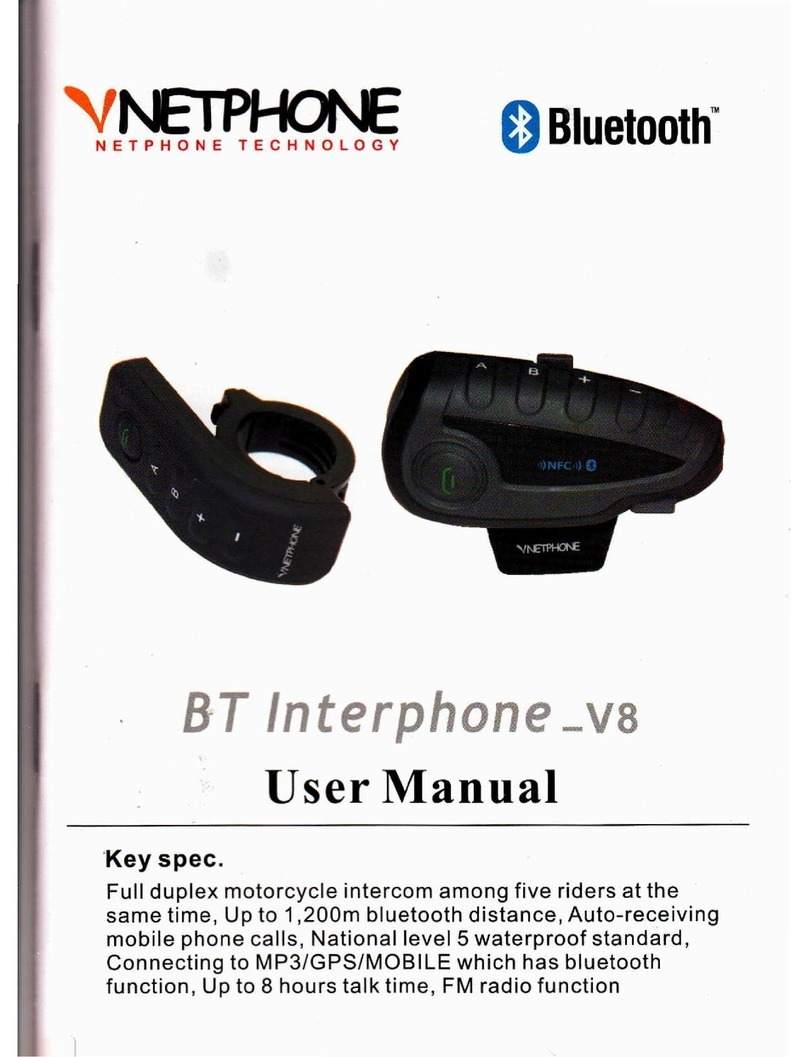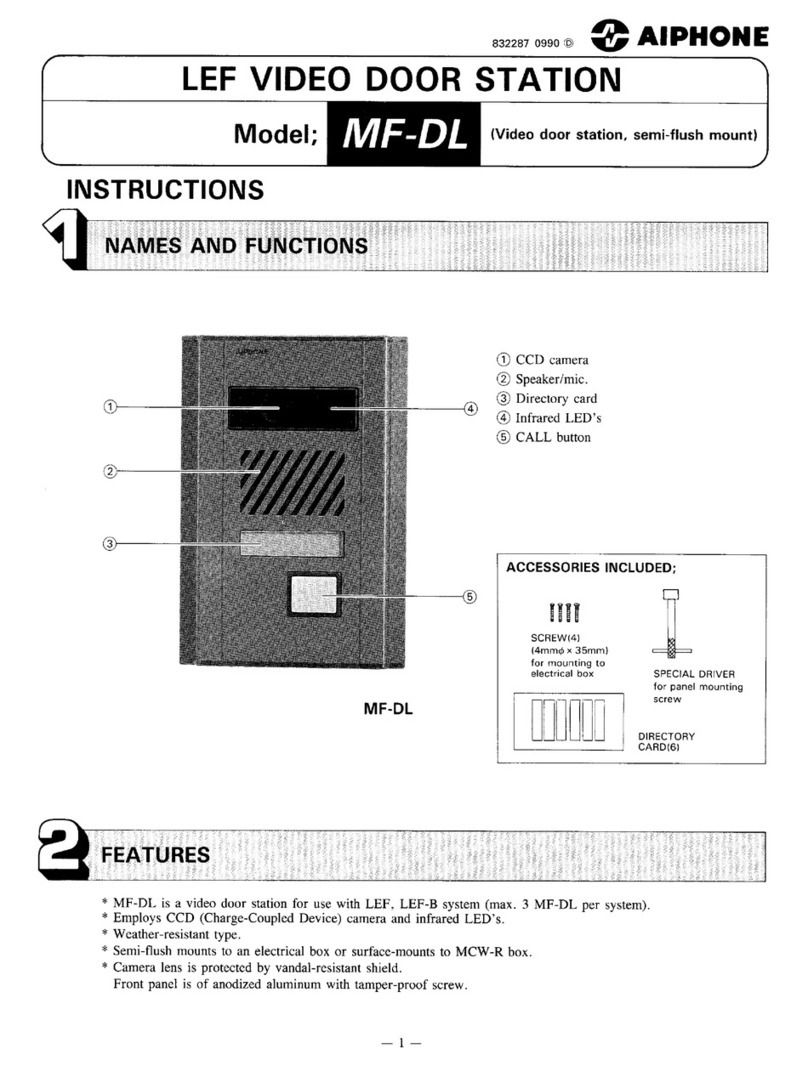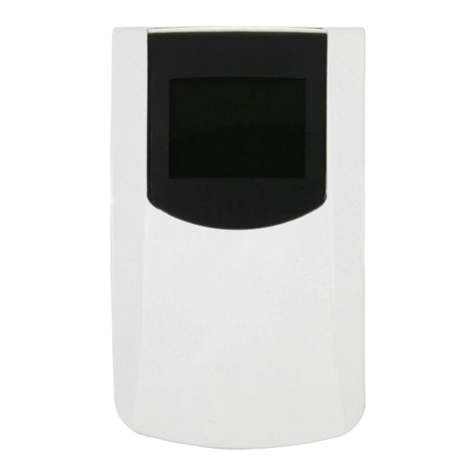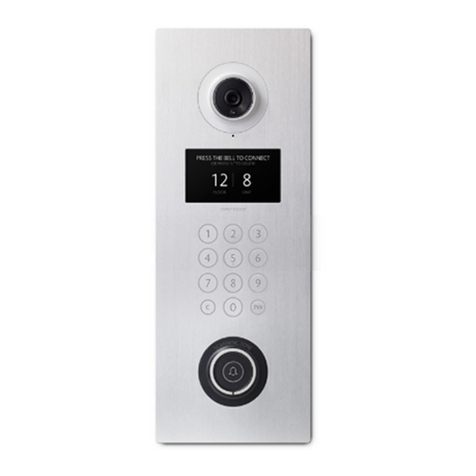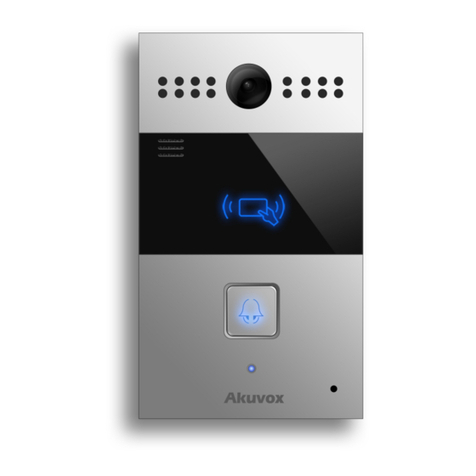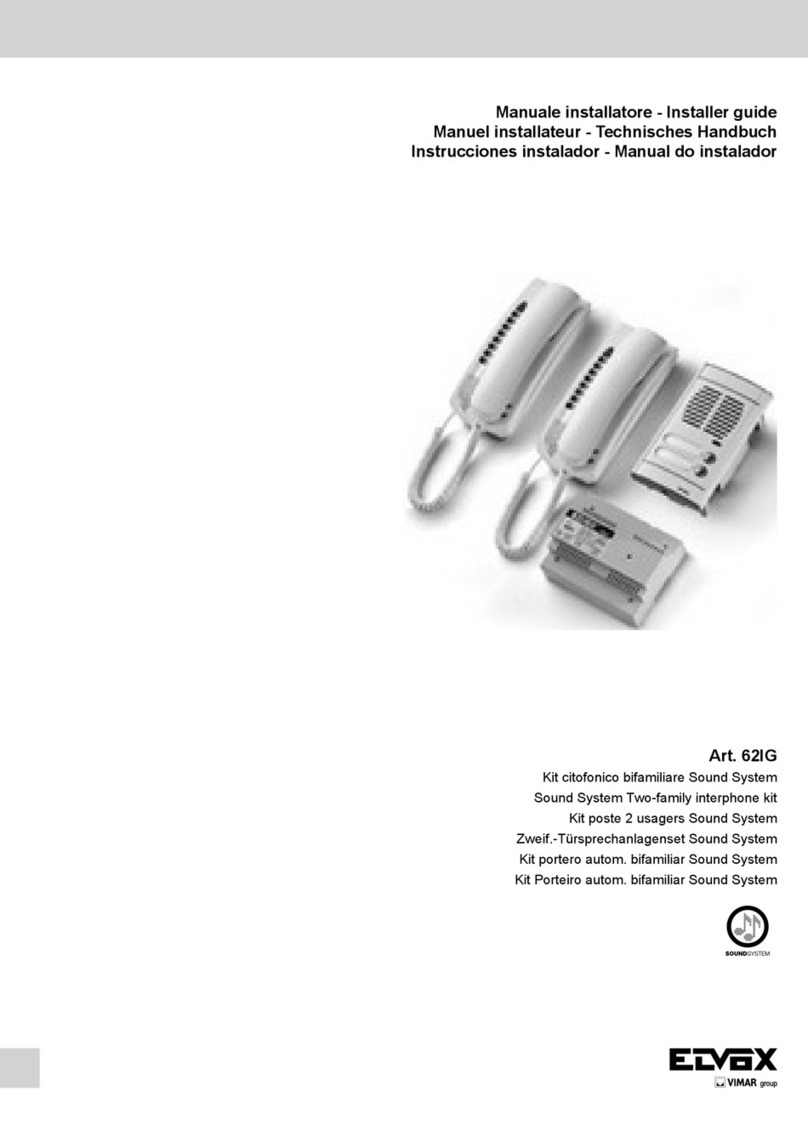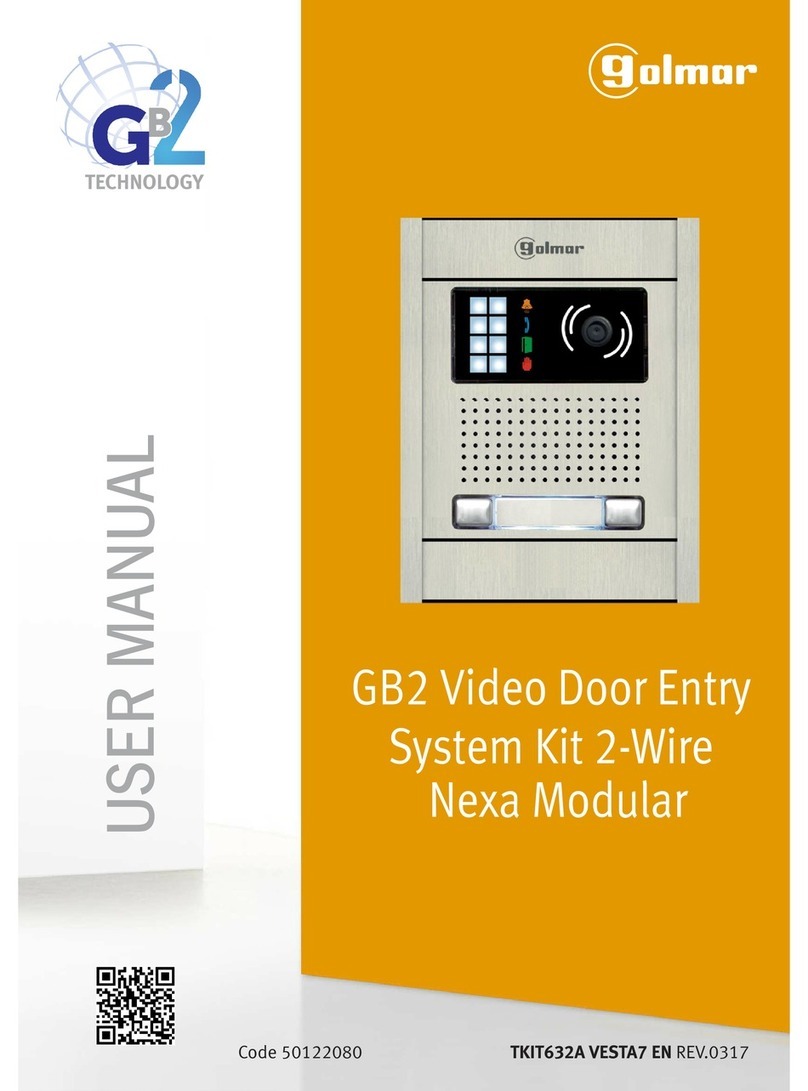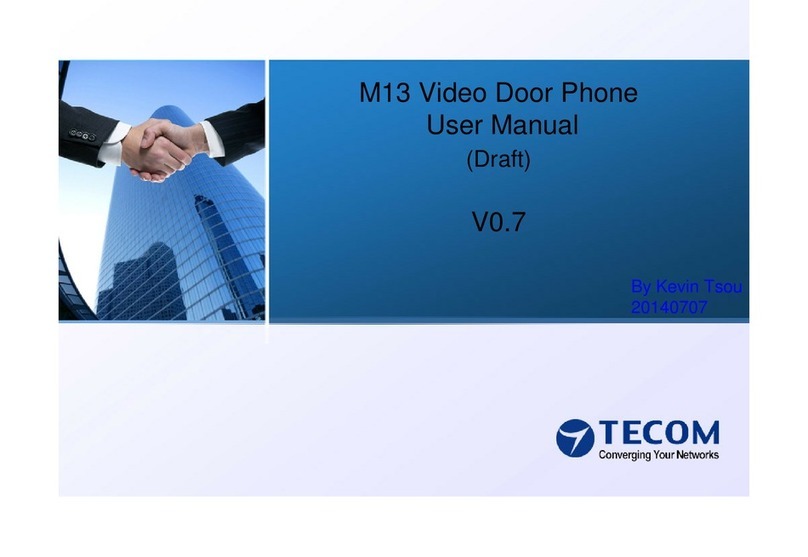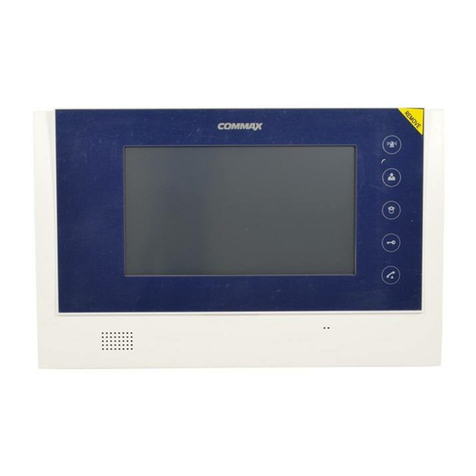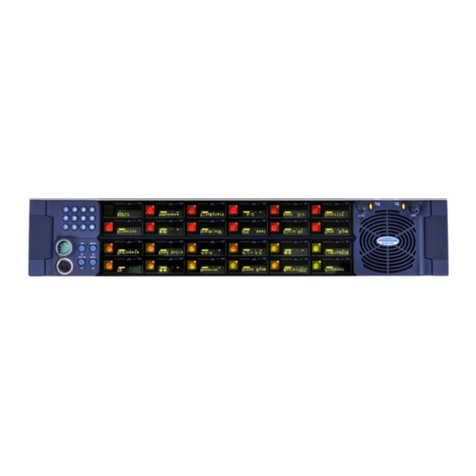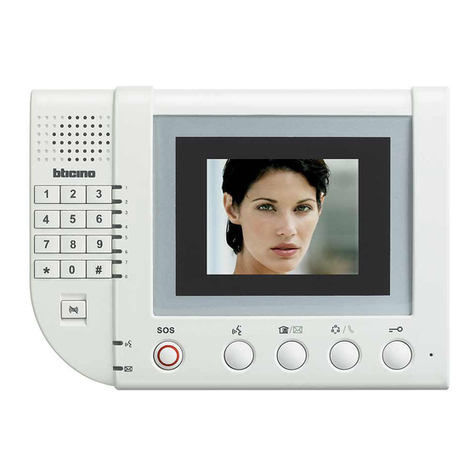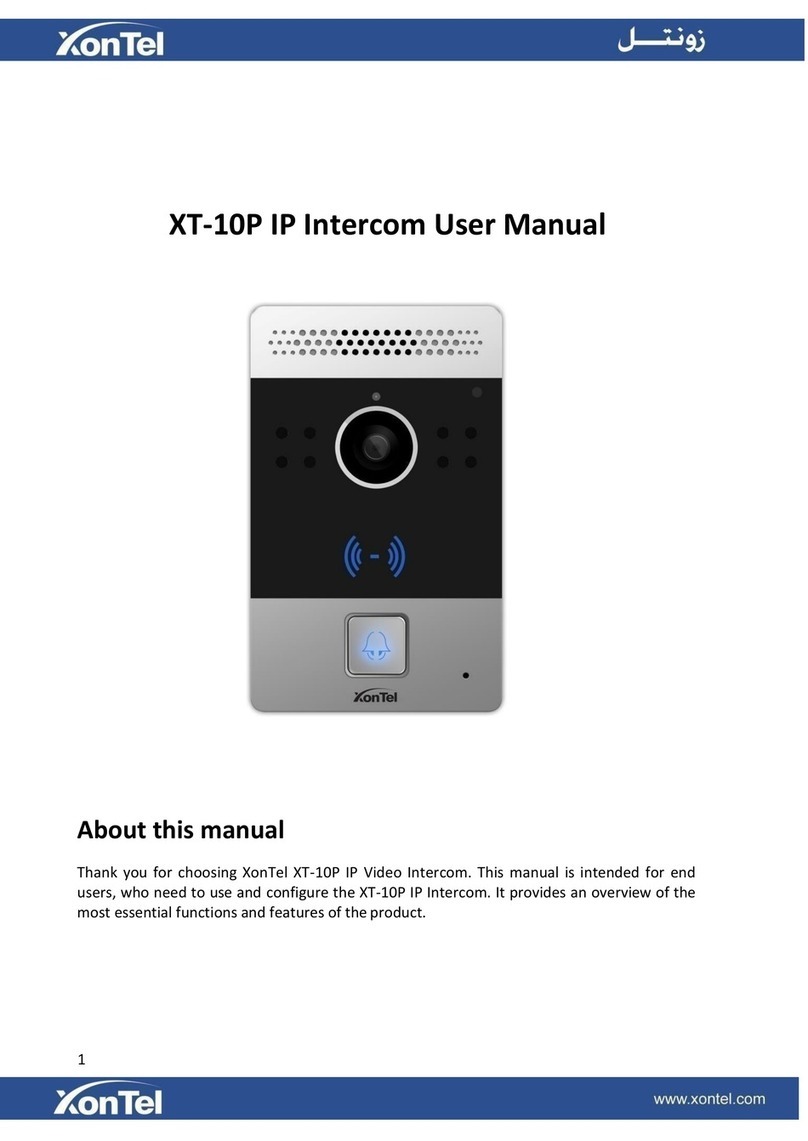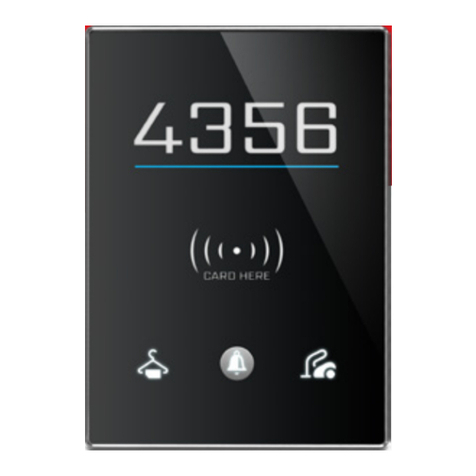Hive TS-NX User manual

TS-NX: GSM DOOR ENTRY UNIT
Installation Manual

TS.NX!
INSTALLATION!MANUAL!
!
Page%2%
Contents
1!FOR YOUR SAFETY......................................................................................... 6!
2!INTRODUCTION ............................................................................................. 7!
3!FEATURES AND APPLICATIONS ....................................................................... 8!
4!START UP..................................................................................................... 9!
5!LED DISPLAY ...............................................................................................10!
6!CLEAR ALL PROGRAMMED DATA FROM SIM .....................................................11!
7!CONNECTION DIAGRAM .................................................................................12!
8!PROGRAMMING TS-NX ...................................................................................14!
9!THE TS-NX PARAMETERS...............................................................................15!
9.1!ALARM SUPPORT ................................................................................................................................ 15!
9.2!OUTPUT MANAGEMENT ...................................................................................................................... 19!
9.3!SECURITY LEVEL -SL ......................................................................................................................... 21!
9.4!PREPAID CARD CREDIT AND VALIDITY INFORMATION ........................................................................ 23!
9.5!SET-UP PARAMETERS ......................................................................................................................... 26!
9.6!SMS MESSAGES EDITOR...................................................................................................................... 31!
9.7!INTERCOM........................................................................................................................................... 32!
9.8!CLIP .................................................................................................................................................... 34!
9.9!EVENT LOGING ................................................................................................................................... 36!
9.10!SPECIAL SMS COMMANDS .................................................................................................................. 37!
10!PRINT-OUT OF THE PARAMETERS ...................................................................39!
10.1!RECEIVE ALL PARAMETERS (PALL) .................................................................................................... 39!
10.2!CHECK SW REVISION (PSW) ............................................................................................................... 39!
10.3!CHECK SIGNAL QUALITY (PSQ) .......................................................................................................... 39!
10.4!RECEIVE TELEPHONE NUMBERS (PTN)................................................................................................ 39!
10.5!RECEIVE LINKS (PLN) ......................................................................................................................... 39!
10.6!RECEIVE INPUT PARAMETERS (PIN) .................................................................................................... 40!
10.7!RECEIVE INPUT FILTER VALUE (PID)................................................................................................... 40!
10.8!RECEIVE OUTPUT FILTER VALUE (POD).............................................................................................. 40!
10.9!RECEIVE DELAY BEFORE DIAL VALUE (PDD) ...................................................................................... 40!
10.10!RECEIVE ACCESS TELEPHONE NUMBERS (PSL) .................................................................................. 40!
10.11!RECEIVE OUTPUT PARAMETERS (POS) ............................................................................................... 40!
10.12!RECEIVE ALL PROGRAMMED SMS MESSAGES (P#) ............................................................................. 41!
10.13!RECEIVE SET UP PARAMETERS VALUE (PPA) ..................................................................................... 41!
10.14!RECEIVE CREDIT PARS PARAMETERS (PCREF) .................................................................................... 41!
10.15!RECEIVE ALL CLIP PARAMETERS (PCLP) ............................................................................................ 41!
10.16!RECEIVE INTERCOM BUTTON 1PARAMATERS (PDEA) ....................................................................... 42!

TS.NX!
INSTALLATION!MANUAL!
!
Page%3%
10.17!STATE OF THE CREDIT FOR THE PREPAID CARD ................................................................................ 42!
10.18!STATE OF THE OUTPUTS (PORC) ....................................................................................................... 42!
10.19!MANUAL GSM MODULE RETARD (MRES) ............................................................................................ 42!
10.20!RECEIVE STATUS OF INPUTS (INS) ..................................................................................................... 42!
10.21!RECEIVE TS-NX LOG ........................................................................................................................... 43!
11!CHANGING PARAMETERS USING THE SMS COMMANDS ......................................44!
12!DEFAULT SETTINGS ON TS-NX .......................................................................46!
13!PARAMETERS PRINT-OUT COMMANDS .............................................................49!
14!TECHNICAL SPECIFICATIONS..........................................................................50!

TS.NX!
INSTALLATION!MANUAL!
!
Page%4%
Figures
Figure 1: TS-NX Connection diagram......................................................................12!
Figure 2: Input Connection diagram. ......................................................................15!
Figure 3: Output Connection diagram ....................................................................20!

TS.NX!
INSTALLATION!MANUAL!
!
Page%5%
Tables
Table 1: IN, ID and DD parameters .........................................................................16!
Table 2: IN, ID, DD parameters example.................................................................17!
Table 3: Remote alarm reporting parameters.........................................................18!
Table 4: Remote alarm reporting example ............................................................19!
Table 5: DTMF control example..............................................................................19!
Table 6: Output management parameters .............................................................21!
Table 7: Output management parameters example ...............................................21!
Table 8: SL parameter............................................................................................22!
Table 9: SL example ...............................................................................................22!
Table 10: Prepaid card validity parameters............................................................24!
Table 11: Credit example .......................................................................................24!
Table 12: Set-up parameters. ................................................................................29!
Table 13: Set-up parameters example. ..................................................................30!
Table 14: Message parameters. .............................................................................31!
Table 15: Message parameters example. ...............................................................32!
Table 16: Intercom parameters..............................................................................33!
Table 17: Intercom parameters example................................................................34!
Table 18: CLIP parameters. ....................................................................................35!
Table 19: CLIP parameters example. ......................................................................35!
Table 20: LOG parameters. ....................................................................................36!
Table 21: LOG parameters example. ......................................................................37!
Table 22: SMS commands. .....................................................................................38!
Table 23: SMS commands example. .......................................................................38!
Table 24: TS-NX default settings. ..........................................................................48!
Table 25: TS-NX parameters print out commands. ................................................49!

TS.NX!
INSTALLATION!MANUAL!
!
Page%6%
1 FOR YOUR SAFETY
Read these simple guidelines. Not following them may be dangerous or illegal. Read
the complete user guide for further information.
SWITCH ON SAFELY
Do not switch the unit on when use of wireless phone is prohibited or when it may
cause interference or danger.
INTERFERENCE
All wireless phones and units may be susceptible to interference, which could
affect performance.
SWITCH OFF IN HOSPITALS
Follow any restrictions. Switch the unit off near medical equipment.
SWITCH OFF IN AIRCRAFT
Follow any restrictions. Wireless devices can cause interference in aircraft.
SWITCH OFF WHEN REFUELING
Do not use the unit at a refueling point. Do not use near fuel or chemicals.
SWITCH OFF NEAR BLASTING
Follow any restrictions. Do not use the unit where blasting is in progress.
USE SENSIBLY
Use only in the normal position as explained in the product documentation. Do not
touch the antenna unnecessarily.

TS.NX!
INSTALLATION!MANUAL!
!
Page%7%
2 INTRODUCTION
TS-NX is a simple GSM intercom communication system that is designed to ensure
low-cost, reliable and single box solution for intercom application. It is designed for
unlimited range, wire free GSM intercom and CLIP support.
In addition TS-NX supports alarm detection, stay-alive messages, credit detection
etc…

TS.NX!
INSTALLATION!MANUAL!
!
Page%8%
3 FEATURES AND APPLICATIONS
Features:
⇒Built-in 4 band GSM module
⇒Up-to 8 buttons call support
⇒2 alarm inputs, 2 additional on extension connector
⇒2 outputs (relay supported)
⇒Up to 100 telephone numbers for CLIP support
⇒Programming by USB SIM Key editor
⇒Download programming by SMS command
⇒Anti-tampering input
Applications:
⇒Single box, wire free intercom solution
⇒Remote gate opener (CLIP)
⇒Simple alarm support

TS.NX!
INSTALLATION!MANUAL!
!
Page%9%
4 START UP
VERY
IMPORTANT
USE A TYPICAL SIM CARD (mini-SIM, see the picture)
WITH MEMORY FOR UP TO 250 CONTACTS!
⇒Insert SIM card to be used for TS-NX in your personal mobile phone.
IMPORTANT
ERASE THE PIN CODE!
⇒Insert SIM card in TS-NX device. The unit must be switched OFF when you
insert the SIM!
⇒Connect inputs and outputs to TS-NX.
⇒Connect the antenna to antenna connector.
⇒Connect power cable to TS-NX device
⇒Connect device to source power supply voltage.
⇒Wait until LED3 display is turned ON (green) and LED1 (blue) starts flashing.
This is set in around 1 minute.
⇒TS-NX unit is now ready to operate.
IMPORTANT
Before sending any SMS commands to TS-NX device, TS-NX
must be in normal operation!
NOTE
TS-NX device will “beep” in 15s interval until the device is not in normal
operation.

TS.NX!
INSTALLATION!MANUAL!
!
Page%10%
5 LED DISPLAY
GREEN LED (LED1)
- Indicates the level of the GSM signal from 1 to 5 LED flashes (1 is weak
signal, 5 is excellent signal)
Red LED (LED2)
- When LED 2 is ON the unit has a problem with a GSM network connection or
the GSM part of the unit is out of order. In this case immediately call the
service!
Yellow LED (LED3)
- Short flashing indicates that the GSM module is ON, but it is not yet
connected on the GSM network. After connection, yellow led is flashing with
short pulse ON and a long pulse OFF.

TS.NX!
INSTALLATION!MANUAL!
!
Page%11%
6 CLEAR ALL PROGRAMMED DATA FROM SIM
This is highly recommended when a SIM card you are going to use for the TS-NX is
not new and it already has some data stored in the phone book memory.
By sending this SMS to TS-NX all programmed parameters and numbers are
cleared:
;SDCLR;
After sending SMS you should wait at least 60 second for the command to be
executed!
NOTE
By sending this command to the TS-NX all programmed data are erased
from the SIM card, including SMS messages! After the device will start it
will be configured with factory defaults.

TS.NX!
INSTALLATION!MANUAL!
!
Page%12%
7 CONNECTION DIAGRAM
Before connection
the TS- NX please
take a look at
connection
diagram.
Figure 1: TS-NX Connection diagram

TS.NX!
INSTALLATION!MANUAL!
!
Page%13%

TS.NX!
INSTALLATION!MANUAL!
!
Page%14%
8 PROGRAMMING TS-NX
TS-NX device supports different types of programming:
⇒To program TS-NX parameters put the SIM card into your personal GSM
phone. Add programming parameters in SIM Card “Phone Book”.
⇒You can program TS-NX remotely by SMS command.
⇒You can program TS-NX with USB key and SIM manager.
⇒You can program TS-NX with direct USB connection, with the use of
configuration software running on PC
NOTE
To receive configuration software for PC please contact your local
distributor.

TS.NX!
INSTALLATION!MANUAL!
!
Page%15%
9 THE TS-NX PARAMETERS
To support versatile functionality of TS-NX different parameters are used. The
parameters are divided in logical sections and are described in the following
chapters.
9.1 ALARM SUPPORT
Alarm reporting is supported by group of different parameters. First section is
used to define the relations needed for alarm to be trigged. The second section is
used to report alarm.
9.1.1 ALARM TRIGGERING
Parameters are used to control (filter) the triggering of the alarm inputs.
9.1.1.1 IN parameter
Alarm input can be on only used as normal open (N.O.) triggered with GND. When
you need the input feedback information it is possible to receive SMS when input
returns from alarm to normal position. To receive the return SMS use IN setting 4.
⇒IN = 0 – Normal Open – triggered with negative voltage (GND)
⇒IN = 4 = IN = 0 + input reset SMS
Figure 2: Input Connection diagram.

TS.NX!
INSTALLATION!MANUAL!
!
Page%16%
9.1.1.2 ID parameter
ID parameter determines time period of the pulse length to trigger the alarm. The
pulse time can be from 0,5 seconds to 9999 seconds. The default time is 0,5
seconds when the parameter value is 0.
9.1.1.3 DD parameter
This parameter is used to define the delay between the time that alarm input is
trigged and the time that alarm is reported.
9.1.1.4 Table of parameters
Name
Comment
IN1
Mode of operation for input 1
IN2
Mode of operation for input 2
IN3
Mode of operation for input 3
IN4
Mode of operation for input 4
ID1
Input time integration delay on input 1
ID2
Input time integration delay on input 2
ID3
Input time integration delay on input 3
ID4
Input time integration delay on input 4
DD1
Time delay for alarm reporting on input 1
DD2
Time delay for alarm reporting on input 2
DD3
Time delay for alarm reporting on input 3
DD4
Time delay for alarm reporting on input 4
Table 1: IN, ID and DD parameters
Example:
♦Direct programming on the SIM card
TS-NX PROGRAMMING TABLE
SIM CARD PHONE BOOK
Name
Number
Description
IN1
0
Alarm activated by connecting to GND
IN2
4
Alarm activated by connecting to GND + RST
SMS
ID1
10
Input 1 has to be valid for 10 second to trigger
the alarm
ID2
0
Input 2 has to be valid for 0,5 second to trigger
the alarm

TS.NX!
INSTALLATION!MANUAL!
!
Page%17%
DD1
0
Reporting of the alarm on input 1 is delayed by
0s
DD2
15
Reporting of the alarm on input 1 is delayed by
15s
Table 2: IN, ID, DD parameters example
♦Remote programming by SMS
;IN1=0;IN2=4;ID1=10;ID2=0;DD1=0;DD2=15;
9.1.2 REMOTE REPORTING ALARM EVENTS
Parameters used to define the way to report the alarm event.
NOTE
TS-NX device send SMS messages for reporting alarm events.
9.1.2.1 TN parameter
Telephone numbers for remote alarm reporting are listed as TN parameters.
Remote alarm reporting on TS-NX is done via SMS messages.
9.1.2.2 LN parameter
This parameter is used to link alarm event from inputs or any other source to the
telephone numbers from TN list.
9.1.2.3 LOT parameter
LOT parameter is used to define the time control for voice calls. The start of voice
connection starts the LOT timer. If the voice connection is still ON when the LOT
timer expires TS-NX disconnects voice connection.
9.1.2.4 Table of parameters
Name
Comment

TS.NX!
INSTALLATION!MANUAL!
!
Page%18%
TN1
1st telephone number
TN2
2nd telephone number
TN3
3rd telephone number
TN4
4th telephone number
TN5
5th telephone number
LN1
Input & telephone No. linking for 1st alarm input (TN1 –
TN5)
LN2
Input & telephone No. linking for 2nd alarm input (TN1
–TN5)
LN3
Input & telephone No. linking for 3nd alarm input (TN1
–TN5)
LN4
Input & telephone No. linking for 3nd alarm input (TN1
–TN5)
LN5
Periodic test SMS. No. linking (TN1 –TN5)
LN6
SIM card refill. No. linking (TN1 –TN5)
LN7
NAC list. No. linking (TN1 –TN5)(see note)
LN8
Log status. No. linking (TN1 –TN5)
LOT
Time out for GSM connection.
Table 3: Remote alarm reporting parameters
NOTE
When telephone number (calling or messaging TS-NX) is not on the CLIP
list, not acknowledge event occurs (NAC). The telephone number
responsible for this event can be send to TN user for notification.
Example:
♦Direct programming on the SIM card
TS-NX PROGRAMMING TABLE
SIM CARD PHONE BOOK
Name
Number
Description
TN1
042376678
1st telephone number
LN1
13
Input 1 reports alarm to TN1 & TN3
LN2
1234
Input 2 reports alarm to TN1 & TN2 & TN3 &
TN4
LN7
1
NAC event sent to TN1
LOT
60
Voice connection stay valid for max of 60s,
after this time

TS.NX!
INSTALLATION!MANUAL!
!
Page%19%
Voice connection breaks
Table 4: Remote alarm reporting example
♦Remote programming by SMS
;TN1=042376678;LN1=13;LN2=1234;LN7=1;LOT=60;
9.1.3 CONTROLING OUTPUTS WITH DTMF
TS-NX can control the outputs with the use of DTMF. This is very useful function
in the intercom application.
To control the outputs the user must press the combination of 2 digits. First digit
is used to select the output (1 to 2), the second digit is used to activate (1) or
deactivate (0) the output. There is a special case when the user can select for
first digit (output selection) number 0. In this case all outputs control by the same
time.
Combination must be pressed in 2s interval, and must be 3s apart to be valid.
NOTE
TS-NX must be in voice connection to support DTMF output control!
Example:
DTMF combination
Description
00
Deactivate ALL outputs
01
Activate ALL outputs
11
Activate output 1
20
Deactivate output 2
Table 5: DTMF control example
9.2 OUTPUT MANAGEMENT
TS-NX supports the possibility to report alarms from inputs and any other events
locally via 2 outputs. The behavior is defined using next parameters

TS.NX!
INSTALLATION!MANUAL!
!
Page%20%
9.2.1 OS parameter
TS-NX device has 2 dedicated relay supported outputs. Outputs can be configured
to different behavior:
⇒OS = 0 – Disabled
⇒OS = 1 – Bi-stable toggle mode
⇒OS = xxx – Mono-stable pulse mode (duration in seconds)
Typical connection for the output:
Figure 3: Output Connection diagram
9.2.2 OD parameter
OD parameter is used to link the alarm event directly to output.
9.2.3 OP1, OP2 parameters
Parameters are used to invert the polarity of the outputs.
⇒0 – normal
⇒1 – inverted
Table of contents

